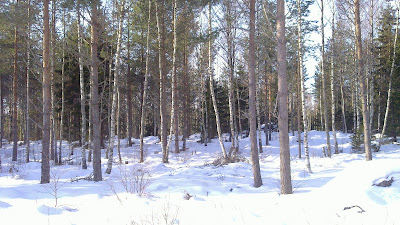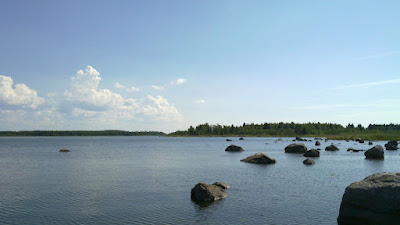#1 Location, location, location
After having compiled a wish-list and a set of goals, the next step in the adventure is trying to find the right plot of land to build on. Take your time with this. It took me around five years to find the right spot. Taking hasty decisions during this process makes it just more regrettable when you come to the conclusion you made the wrong choice. During the search, you can also use the time available to flesh out the details on the building itself, the power system, etc. - all things you won't have time for once you start the building process.
 |
| It took me 5 years to find this spot. |
The best firewood available in Finland is Birch. Most of the cheaper plots are (former) tree farms which mostly grow a mono-culture of Spruce, or maybe Pine. This is not just limiting when it comes to firewood, the mono culture makes for a rather boring forest with limited wild life. Freshly harvested clear-cut land is also cheap, and can be turned into a wonderful diverse forest, but it will take decades to get there. A selective-cut would be a somewhat easier starting point. Added to all this, a regular forested plot will mean your place is completely surrounded by trees which limits other aspects such as solar power generation, and is quite dark in general. Being surrounded by forest is usually also a good way to be devoured by mosquitoes and other biting bugs in summer without reprieve.
 |
| Shores are good! |
Ideally, we are looking for a plot that has forest, but also a shoreline of sorts. The shore could be a lake or the sea, or even a river. Failing that, an area that has a large meadow or other type of open clearing would be possible. This is not only good for utility, but the view can make or break the experience - don't forget the aesthetics! If the shore is on the south side of the property, it's even better. If you're aiming for food self reliance, this will be a top priority since a lake, sea or river can provide fish (sometimes year round - ice fishing!), while an open meadow or clearance attracts game. Oh, and in the end, you want the plot to be as big as you can afford. This way you can make sure you won't have neighbors, or that the area around of your future home don't get clear-cut.
When going around to check out potential places, I recommend bringing a compass and a map (preferably a digital map, with the plot perimeters on). With the compass you can easily determine if the place is suitable for future solar, and might even give an idea on where the panels could go. It also determines what the orientation of the building will be, and if you can enjoy a nice sunrise from your future kitchen. With the map and GPS, you can walk the perimeter (or at least part of it) to get a proper first lay of the land. Make an estimate of the amount of trees there are on the land, size of the trees and species, other plant species (berries, Juniper, etc.), and age of the forest.
Try to see if there are any obvious areas that are situated at higher elevation; there are terrain maps that can help with this too and try to find out what's under the top soil: stone, sand, clay,... bringing a metal rod is helpful. Also be aware that even though land might be dry during your visit, it could actually flood during autumn or spring - look for those signs.
The reason for these preliminary terrain checks is to get an idea of where the building will go. For proper drainage, you want to build at the highest elevation so water can drain away from the building in all directions, not towards it. This will also help with your future waste water drainage. If the soil is soft and wet, this can easily cause issues building a proper foundation. In fact, this is one of the reasons I would not build too close to the shore. You want to drain water away from the shore, not towards it (especially waste water even after processing), and building on too soft or wet sub soil will make the whole foundation and building shift over time. Frost heaving is also a big concern in a cold climates: frost/defrost cycles can cause lift that can damage the foundation.
For my plot, I absolutely wanted to have a seashore. I went to check several plots with a lake front, but the sea front properties always had a more open and free feeling to it. Seeing water as far as the horizon and knowing there were several islands waiting to be explored (by canoe) only amplified this feeling. The choice of the plot is therefor not just an objective choice based on the facts, but also a more subjective choice based on how it makes you feel - and this might be something that only develops after you've visited a few places. Do take your significant other with you to make sure the feeling is mutual, and do visit more than one time to make sure it's real and not driven by anxiety to get going, or fear of missing out.
 |
| Sea-buckthorn |
Finally, if the plot ticks all the boxes above, make sure it is properly accessible. If you're only able to get there using an ATV, you'll have problems getting building material to the site. If you build a small cabin, you can make it work, but anything larger needs a somewhat proper road for truck deliveries. If the road exists - great! If not, plan in your budget to add one and see if it all still makes sense.
Once you make the decision to buy the plot, as the new owner, you should get to know the terrain and your new resources in great detail. Don't start building right away: give it at least a year. You want to know how the land behaves in all seasons: are there flood regions, is the road only usable for heavy trucks when it's freezing, how does the wind behave on the terrain, any wildlife tracks you can identify, how is berry season and do you find any good mushrooms, etc. Go camp on the land, build a fire, grill some food. In other words: don't stress about building just yet. Get to know the location first, and get to know it well. I spent several years owning the plot before I started building.
Before I discuss the foundation work, I'll spend the next blog discussing the building itself. I'll explain why it looks the way it looks, the materials used in the building, and the planning required before breaking ground.




Comments
Post a Comment